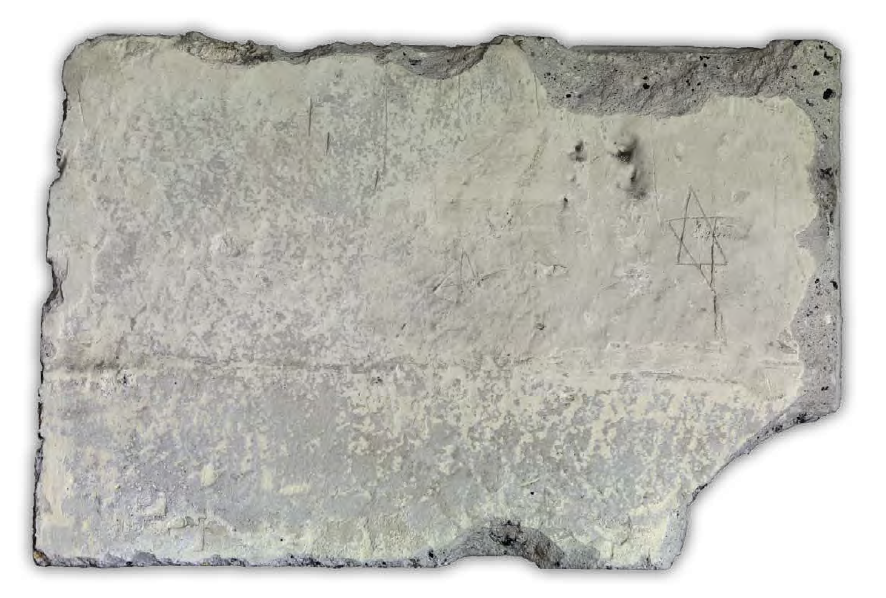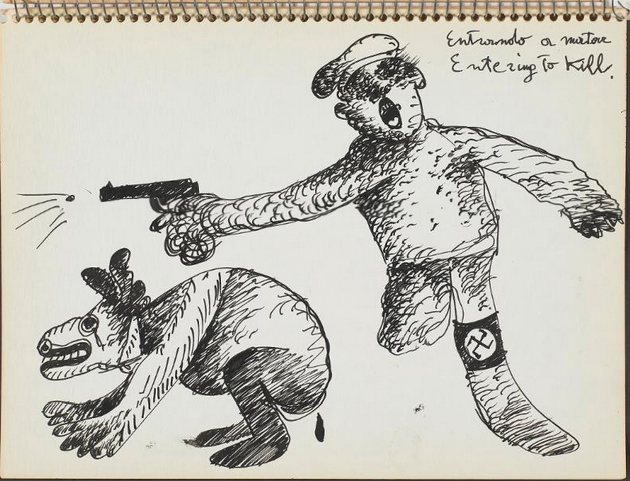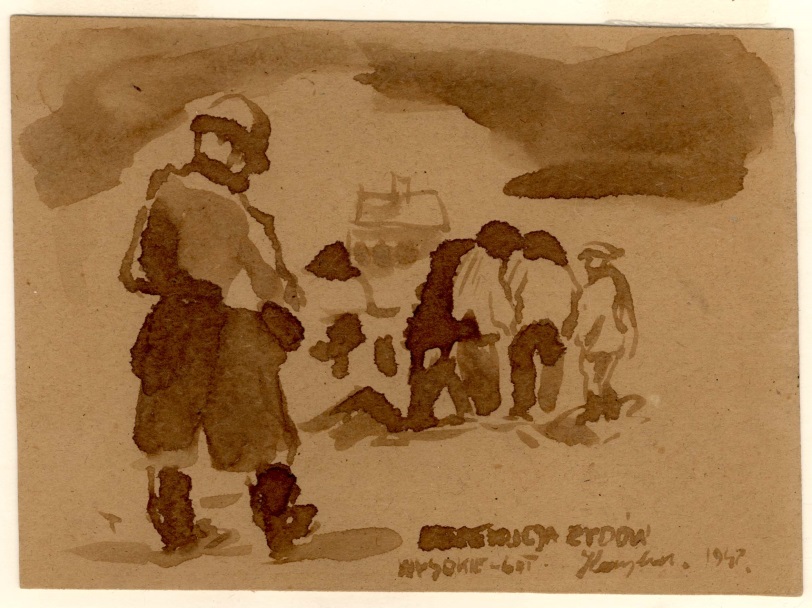Holocaust by Bullets: Expanding the Field of Holocaust Art
Dr. Roma Sendyka
1. Visual inattention
In this paper I would like to examine the consequences for art research of the growing importance of a term that reshapes recent research on the Shoah. The “Holocaust by Bullets” (Desbois) allows seeing beyond the powerful figure of the extermination camp that usually - and justly – focuses the attention of scholars in the field of Holocaust studies. Today we know more and more of how profoundly the “dispersed Holocaust” – the uncountable atrocities of individual deaths in towns, villages, narrow streets of lesser ghettos - left its mark on the region, leaving “bloodlands” (Snyder), “shattered spaces” (Meng) and “tainted landscapes” (Pollack) behind. But did it leave art?
As stated in recent documents of the International Holocaust Remembrance Alliance: “experts estimate that more than a third of the Jewish victims of the Holocaust as well as other groups of victims were murdered by shootings. The perpetrators - mobile killing units consisting of Einsatzgruppen, police battalions, Wehrmacht, collaborators or a combination of the aforementioned – obliterated entire communities in a few days or even mere hours” (IHRA 2014: 1, emphasis R.S.). Therefore, one may assume that two million were killed too hastily, “in a few days or even mere hours”, thus making it impossible for them to produce the response that could be included in the field commonly defined as art: i.e. “art… viewed as a form of documentation, witnessing, and spiritual resistance that plays a very important historical role as evidence from the victim’s perspective” (Feinstein, YIVO).
My argument here will be that the line of thinking that “there is nothing left” from the events “East of the camp”, in crucial respects, remains held within a conceptual enclosure where Holocaust art is still theorized from the standpoint of a subject placed at the center of a camp, or in a relation to it: as a fugitive from it, or hiding, avoiding a deportation to it. I do not want to uncritically succumb to the consequences of the above assumption; namely, to the hypothesis that there is no visual report from the other “victims' perspective”, of those standing “outside of the camp” at killing pits, to be shot. In short, I would argue that the acceptance of the supposition that there is no art from the hasty, brutal, chaotic events of the “Holocaust by Bullets” would be close to the position that was forcefully denounced in 2001 in Images malgré tout where Georges Didi-Huberman criticized generalizing statements about an alleged invisibility, unfigurability or unrepresentability when it comes to the horrors of genocide. His point was that it was our pre-conditioning of reasoning, both within the fields of aesthetics and of historicity, that made us overlook certain events and certain images. Whereas, there almost always is “something – very little” that “remains of a process of annihilation: that something, therefore, bears witness to a disappearance”, ruining “murderer dreams” to “erase all” (Didi-Huberman 2008: 167). If it is researcher/interpreter “inattention” (ibid. 33) that empties the field of observations, then, in the following, I would like to attempt to adjust our critical methods so they may allow us to see “the invisible” or acknowledge the existence of the “non-existent”: namely, “the Holocaust by Bullets Art”.
2. Marks on trees, cuts on walls
Since the East Einstazgrupen in 1942 “obliterated entire communities in a few days or even mere hours”, the potential witnessing artist might have had very little time to react visually, unlike the victims who created art under prolonged circumstances of entrapment in concentration camps, in ghettos, or while in hiding. It is safe to assume that traditionally valued grand genres of artistic production (oil paintings, sculptures) will not to be found in such conditions. Hypothetically, what can be found would be “witnessing done in extremis” (Janczewska, Leociak 2012): cuts on trees, dropped pieces of paper with hasty sketches, maps or notes; marks on walls or stones, all unlikely to be included in the artistic dimension. Paraphrasing Paul Ricoeur from his Memory, History, Forgetting (Ricoeur 2004: 433), I would strongly claim that the supposed trace cut in bark “has to be placed back at the center of this totality of images”. And that which allows us to carry out this relocation is the methodology of visual culture. The “pictorial” or “iconic” turns proposed in the early 1990s by W.J.T. Mitchell and Gottfried Boehm were attempts that later solidify into a radical opening of the visual field. At the core of those considerations was a “rediscovery of a picture as a complex interplay” of many socio-cultural factors (Mitchell 1995: 16), which consequently produced work that complicated and added nuance in the mere identification of study objects, suggesting complexity of the category of visual representation and the need to re-conceive its forms, nature and roles.
Thus, my first step in enhancing my research apparatus in search of “the Holocaust by Bullets Art” will be to allow for an “extended category” of study objects, encompassing “representations of lesser importance”, usually confronted with academic inattention. But James Elkins, progressively dismantling the borders of contemporary research in art and taking a direction towards a radical de-centering of art history studies, once stated openly: “most images are not art”. We need hence to consider that “there is another group of images that has neither religious nor artistic purpose, and that is images principally intended – in the dry language of communication theory – to convey information. There is no good name for such images, which include graphs, charts, maps, geometric configurations, notations, plans, official documents, some money, bonds, seals and stamps, astronomical and astrological charts, technical and engineering drawings, scientific images of all sorts, schemata and pictographic or ideographic elements in writing: in other words, the sum total of visual images that are not obviously either artworks or religious artefacts. In general, art history has not studied such images, and at first they are intrinsically less interesting then paintings. They seem like half-pictures, or hobbled versions of full pictures, bound by the necessity of performing some utilitarian function and therefore unable to convey more freely. Their affinity with writing and numbers seems to indicate that they are incapable of the expressive eloquence that is associated with painting and drawing” (Elkins 2001: 4). It appears to me that precisely among those “half-images”, “hobbled versions of full pictures”, “utilitarian objects close to writing and numbers” that we may find the visual objects we need to fill the visual field of the “Holocaust by Bullets”. In fact, a recent endeavor by Denis Peschanski, Benoit Pouvreau, Thierry Zimmer and Mélanie Curdy (Peschansky et al., 2014) may well illustrate how successfully such an open attitude toward visual heritage of the Holocaust may expand our research perspective. An album of photographs (Les Graffiti du camp de Drancy. Des noms sur des murs) of the drawings on the walls in buildings in Cité de la Muette near Paris, where Jews were held while in transit to Auschwitz, illustrates the effects of a powerful need to leave a personal mark, name, a poem, or a drawing "for memory." One of the pages of the book pictures a Star of David hastily drawn in the upper-right corner of a concrete brick. Slightly flattened, and leaning to the right, it seems to float or fly up, free despite its feeble structure suggested by trembling lines. This graffiti may seem formally “intrinsically less interesting then paintings”, but is it devoid of “expressive eloquence” or “witnessing abilities”? I would say it is eloquent enough to make us speak. The use of both art history and visual culture may let us recognize and react to the “hobbled art” made in haste and under pressure of time.

Ill.1 Graffiti on the wall of a building in the Drancy camp. Région Île-de-France - Jean-Bernard Vialles -Département de la Seine-Saint-Denis, Archives nationales, ADAGP, 2011.
3. Belated pictures, snatched apparitions
I would stress, therefore, the need to make the research apparatus more refined, even microscopic: looking for tiny objects, seemingly unimportant, that did not get into collections or archives. I would then strongly agree with the claim made by George Didi-Huberman that “if the terror of the camp” – let me add: terror of ghettoes, killing sites, in-the-woods ravines – “defies imagination, then each image snatched from such an experience becomes all the more necessary. Each apparition – however fragmentary, however difficult to look at and to interpret, in which a single cog of this experience is visually suggested, becomes all the more necessary” (Didi-Huberman 2008: 26, emphasis R.S.). This claim may be easily refuted: it is hardly possible to find such artefacts after 70 years. Who would recognize the cuts on trees? How can we find dropped pages of notebooks? The marks on walls may be covered by thick layers of paint by now. A wishful attempt? – perhaps. But recent developments in Holocaust archeology show that much can still be done, despite the passage of time. Caroline Sturdy Calls from Staffordshire University proved that the landscape could never be sanitized in such a way, that “there is nothing left to see”. Sturdy Calls began assessing Treblinka as an archeological site in 2007. Her emphasis was on using "non-invasive" archaeological methods, including geophysical surveys of the site and visual inspection: both methods allowed her to find foundations, mass graves but also tiny artefacts – with time, one may assume, such work will reveal also residual visual marks – on excavated objects, on disclosed ruins.
Similarly, we may seek help with oral historians. A much under-researched aspect of Holocaust history, the issue of by-standers, seems to attract more and more scholarly attention. The body of available audial material from field interviews increases (see for instance the archives of Yahad-In Unum Foundation in Paris). But if I may judge from available printed recordings (see: Desbois, 2008), the question if the victims had left any notes or drawings on the site where they were kept (sometimes for hours) in wait for the execution, if they had dropped a page with a map or sketch, if a cut on a tree or wall had been spotted afterwards, is not asked, probably being of lesser importance to a historiographer. If Holocaust art historians can ally with oral historians and archeologists of the Holocaust in order to make the research apparatus more sensitive to nuances and tiny visual anomalies, the extent of visual representations of victims expressing their fate under the bullets of the Einsatzgruppen may grow with time.
We may thus wait for “belated” “half-pictures” found in the course of field work, but we may also allow for another expansion of the core definition of “Holocaust art”. Instead of enlarging the field of analyzed objects we may allow for an extension of temporal limits. We may include representations “of documentation, witnessing, and spiritual resistance” done not during the Nazi occupation, but much later by the victims who survived executions in the East. Some of these artists are well known, for example Jonasz Stern (1904-1988). His works are, of course, interpreted in relation to traumatic events he witnessed; however his abstract compositions have not been read as a visual representation of the “Holocaust by Bullets”.

Ill. 2 Jonasz Stern, Silence of Species, ©National Museum, Wrocław, 1965
Another artist who has recently come to broader public attention is Pinchas Burstein (1927–1977), later known as Maryan S. Maryan, a Polish-born Jewish expressionist painter residing after the war in Palestine, Paris and then New York. As a child he survived an execution in Rzeszów. Shot in the eye and neck, he was found amongst the corpses and carried to a hospital by another Jew. Maryan explicitly returned to the events of the winter 1942/43 only much later, in his notebooks drawn during psychoanalytical treatment in the 1970s.

Ill. 3 : Maryan (1927 - 1977), Carnet de dessins N°4, 1971; © Philippe Migeat - Centre Pompidou
The art visualizing the events of killing sites by victims is therefore possible, but belated; produced not as a visual document during the mass murder but later, as an effect of a recurring mental image. This then would be my second suggestion for a possibility of “Shoah par balles” art: looking for “apparitions”, phantom images, the indistinct representations of past trauma in much later works.
A third option that we may consider in search of the “Holocaust by bullets” art is the other witnesses. If the victims rounded up for executions lacked time and resources to make visual comments of their fate, the bystanders may be accepted as their stand-ins. Józef Charyton, who lived near the ghetto in Wysokie Litewskie, assigned himself the role of historical witness. He followed the Germans' mass executions, later “hurrying back to the workshop to sketch everything, having great plans to reconstruct the most horrible scenes on large canvasses for historical record” (Charyton 1963, 4-5). What resulted from this earnest and morally driven mission were hundreds of aquarelle sketches (today mostly in the possession of the Jewish Historical Institute in Warsaw), done by a hasty hand on random scraps of paper.

Ill. 4. Józef Charyton, Execution of Jews, Wysokie 1942, Yad Vashem
In summation: finding the “Holocaust by bullets art” may be an endeavor similar to chasing half-pictures, apparitions, mental post-images recurring like nightmares. It may require weary searches in archives for scraps of packaging paper on which onlookers might have made their visual notes; it may involve searching for unclear marks on trees and unreadable scribbling on walls. Not being an easy task, the envisioned research will also require a revolution of sorts in the field of Holocaust art history: relaxing customary definitions to allow the inclusion of “images that are not art” in the research of art history; accepting an extended time frame for “Holocaust representation”, far beyond the one attributed to historical events; and allowing for viewer substitutes: the “borrowed eyes” of an empathetic bystander might be allowed to continue the observations of a victim led to a dark ravine.
But what would happen if such actions will not be taken? Since the Holocaust is a “moral event” that makes “unusual demands” to be exposed and represented (Lang 2000: x), we may be certain that in absence of the “Holocaust by bullets” images by victims, other pictorial representations will fill in the visual gap: the epideictic of today's culture will elevate the photographs by perpetrators (e.g. the photo from Ivangorod of a mother protectively cuddling a baby targeted by a shooting soldier, done unconsciously in a familiar Magnum Photos poetic imagery style; or the photo from the Mizocz ghetto shootings, of the naked bodies of women piled up on the slopes of a ravine reminiscent of Les Oréades by William Bouguereau) to an iconic position. Thus, the issue of the “Holocaust by Bullets” makes urgent demands on the researchers and the very discipline of art history. Broadening the borders of the discipline and expanding the methodologies are no longer a mere theoretical possibility but a necessary ethical response to the fate of victims bereft of pictures attesting to their fate.
I would like to thank you the participants of the EHRI workshop on Holocaust Art (Yad Vashem, February 2015) for discussions and comments that helped to shape the article.
Dr. Roma Sendyka is the Director of the Research Center for Memory Cultures, Jagiellonian University, Krakow, Poland
References:
Charyton, Józef. Wysokie Litewskie podczas okupacji hitlerowskiej [Wysokie Litewskie under Nazi occupation]. Copy of a testimony no. 6.133 for the Jewish Historical Institute in Warsaw. Feb. 6th1963. Available online: http://www.nawschodzie.pl/holokaust.html (entered Feb. 28th. 2015)
Desbois, Patrick. The Holocaust by Bullets: A Priest’s Journey to Uncover the Truth behind the Murder of 1.5 Million Jews. Transl. by Catherine Spencer. New York: Palgrave Macmillan, 2009.
Didi-Huberman, Georges. Images in Spite of All: Four Photographs from Auschwitz. Transl. by Shane B. Lillis. Chicago: University of Chicago Press, 2008.
Elkins, James. The Domain of Images. Ithaca: Cornell University Press, 2001.
Feinstein, Stephen Charles. Art and the Holocaust. The YIVO Encyclopedia of Jews in Eastern Europe.
http://www.yivoencyclopedia.org/article.aspx/Holocaust/Art_and_the_Holocaust (entered Feb. 28th, 2015).
IHRA: Report from the plenary conference of the International Holocaust Remembrance Alliance, „Killing Sites” (May 2014): https://www.holocaustremembrance.com/focus/killing-sites (entered Feb. 28th, 2015).
Janczewska, Marta and Jacek Leociak. Świadectwo spisywane in extremis. In: Buryła, Sławomir and Dorota Krawczyńska. Literatura polska wobec Zagłady (1939-1968), Warszawa: IBL, 2012.
Lang, Berel. Holocaust Representation: Art Within the Limits of History and Ethics. Baltimore: John Hopkins University Press, 2000.
Meng, Michael. Shattered Spaces Encountering Jewish Ruins in Postwar Germany and Poland. Cambridge, Mass.: Harvard University Press, 2011.
Mitchell, W. J. T. Picture Theory: Essays on Verbal and Visual Representation. Chicago: University of Chicago Press, 1995.
Peschanski Denis, Benoit Pouvreau, Thierry Zimmer, Mélanie Curdy. Les Graffiti du Camp de Drancy. Gent: Snoeck Publishers, 2014.
Pollack, Martin. Kontaminierte Landschaften: Unruhe bewahren. St. Pölten: Residenz Verlag, 2014.
Ricoeur, Paul. Memory, History, Forgetting. Transl. by Kathleen Blamey and David Pellauer. University of Chicago Press, 2004.
Snyder, Timothy. Bloodlands: Europe between Hitler and Stalin. New York: Basic Books, 2010.
